The Culinary Literacy Center Edible Alphabet Program
Edible Alphabet at the library is a free series of classes that teaches English through cooking. Language learning through cooking began at the Culinary Literacy Center of the Free Library of Philadelphia, in 2016. Since transitioning to Zoom, participants from all over are welcome, space permitting.
Origins
Pre-pandemic, students cooked and ate and talked together in the Central Branch’s commercial-size demonstration kitchen. Classes were also held in four neighborhood libraries. Covid caused the meetings to pivot to virtual gatherings in May 2020. During months of social isolation, it became even more important to promote community and connection. The program is a valuable opportunity for many newcomers to practice and maintain language skills.
“Food is one of the great unifiers…Before you speak someone’s language, before you understand their history, before you walk a mile in their shoes, you eat the same food that person eats, and get some insight into how their life works, the way their culture works…it’s such a wonderful window into other aspects of the multicultural societies that we live in.” —Adam Liaw, in conversation with Yotam Ottolenghi, reported by the Guardian
English Language and Cultural Literacy
Edible Alphabet at the Library seamlessly integrates three major interests in my life– food, language, and education. My degree is in TESOL (Teaching English as a Second Language). And my life-long interest is FOOD (no explanation needed). Even though the fall series was already midway in-progress, I was welcomed warmly, as are all new arrivals. Each class begins with student introductions, guided conversation, and vocabulary review for the recipe. I am meeting students from China, Japan, Korea, Brazil, Russia, Haiti, Mexico, Taiwan, Pakistan, Ethiopia, Italy, and Colombia. Thanks to the students and teachers who have been so hospitable, each week is a new learning experience.
The Edible Alphabet Transition to Virtual Learning
Since the pandemic shuttered the public library kitchens, the staff packs free groceries so students can cook at home. Currently, the recurring series meets once weekly for two hours on Zoom. Although some Culinary Literacy Center events are returning to in-person, this series will continue online at least through the end of March. Ingredients (sponsored by Dietz and Watson) are picked up at local branch libraries. Due to cultural, dietary and financial considerations, all recipes are vegetarian and fast cooking.
The Edible Alphabet Program Goals
I spoke with program manager, Lindsay Southworth, who revised the curriculum in 2018. Lindsay very graciously shared background information, recipes, and curricula. The goals of the program are to assist English language learners gain language skills, connect them to the library and the services available to them, and to build strong community prepared to engage in the cultural and civic life of the city of Philadelphia.
Lindsay discussed the advantages and disadvantages of conducting the session online. While hopeful to be able to eventually return to in-person classes, she said that the virtual sessions are working surprisingly well.

“Cooking together online has managed to maintain the warmth of connection. The spirit and both interpersonal and language skills have flourished.”
Furthermore, the program has grown to include people who don’t live geographically in Philadelphia. Elisabetta, an immigrant to the USA, has been joined online by her sister in Italy. Likewise, for those with transportation, childcare, or mobility issues that prevent them from attending in-person classes, the cook at home model is an advantage.
Of course there are challenges for those without digital literacy skills or access. The program is designed to be flexible, and all are welcomed whenever they can show up online. Edible Alphabet at the library is one of several programs that serves non-native English speakers. For instance, an asynchronous language through cooking series is also being beta-tested.
The Ingredients
The most popular dishes taught use ingredients familiar in many cultures, such as garlic, onions, ginger. In addition, partaking in comfort foods together is a warm way to welcome newcomers. Therefore, traditional cuisines may differ, but the communal practice of sharing food remains universal.
Some recipes used in the class come from the cookbook Good and Cheap. This resource provides words for the ingredients, as well as practical tips for getting the best value by cooking seasonally. Other recipes are developed by the chef instructor, and some are suggested by the students themselves. For example, Shiro Wat*–by Tigist from Ethiopia, and Chirashizushi**–by Hajimi from Japan.
Practicing Conversation
Throughout each Edible Alphabet at the library session, students practice English conversational skills. English proficiency, as well as culinary experience may vary widely in a class. However, food is the common language.
“The EDIBLE ALPHABET program helps me feel very much that I am not alone. There are people who understand that I am just learning English and it is very difficult for me. The people in the EDIBLE ALPHABET program do not just work in this program, they show kind emotions to us. We have a chat where we communicate, we feel not like just people who cook, but as people who are united by the idea of helping each other.” – Helena
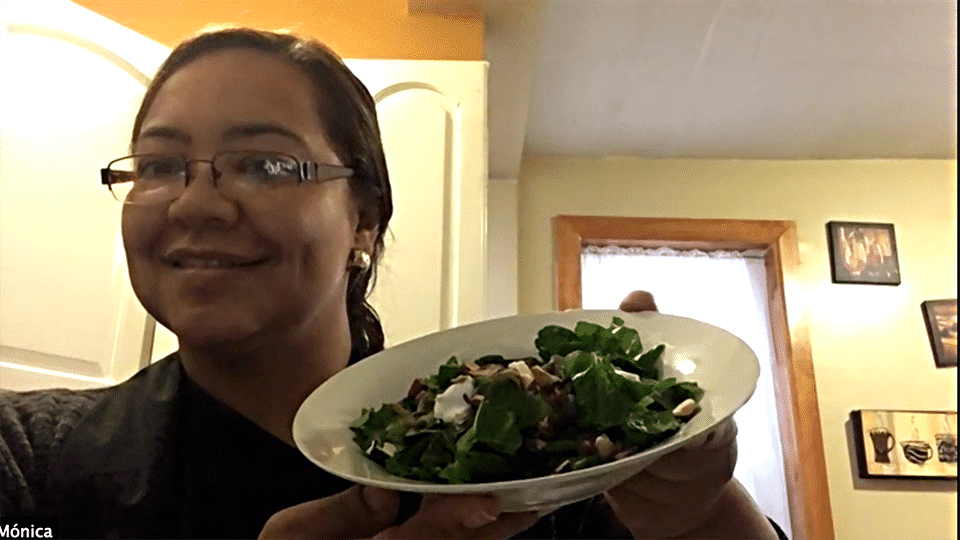
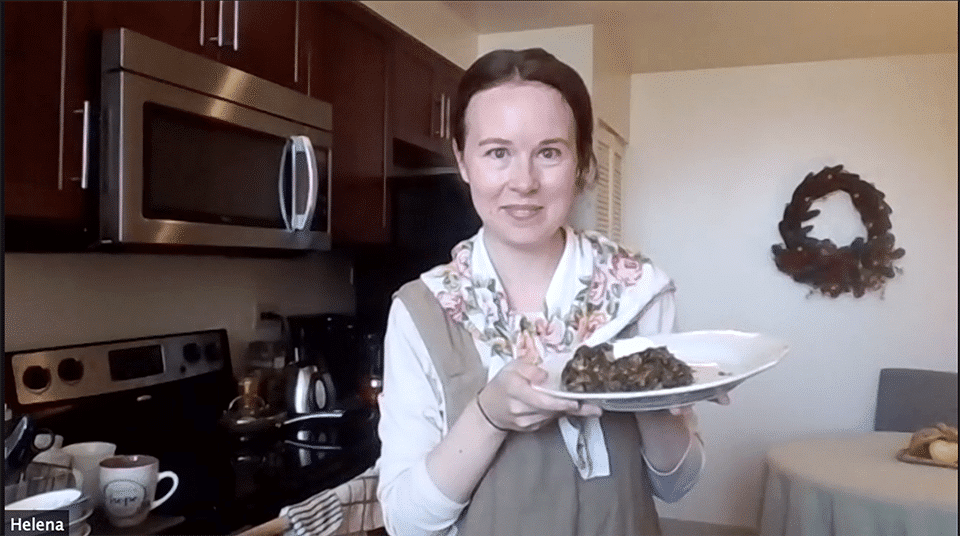
The students are an incredibly diverse and open group of (mostly) women and an occasional man. The ten to twenty students are bound by a passion for food, a need for social interaction, and immense gratitude for their teachers. Lindsay, Heather, Chef Genevieve, and Sally create the supportive environment helping students to adjust to life in their new homeland.
Edible Alphabet Ice-breakers
The English teacher provides prompts such as “What is your favorite meal of the day?” She compassionately encourages the students to feel confident taking risks. Next, small group breakouts with the prompts like “How do you prepare beans in your culture?” evoke responses. In Flavia’s home country of Brazil, beans are eaten every day. A nurse by training, she still bakes typical Brazilian cheese bread regularly. Recently, we arranged a meet up so I could introduce my family to her delicious frozen bake-at-home snacks. What a treat! She is still searching for a great restaurant fejioda in her new home. Hajime explained that Japanese eat Adzuki beans, and sweet bean paste. Beans are not popular in Russia, said Helena.
Friendship in a Global Community
Tigist, a newlywed, showed her wedding ring one week, and introduced us to a traditional Ethiopian stew recipe another. Allenda, a newcomer from Haiti was introduced to Marie, also Haitian. I spoke with Helena, a Russian Orthodox icon painter, who recently immigrated from Russia. She said that ‘the bonus is a good meal for her husband on Wednesdays.’ Mónica came from Mexico five years ago with ‘no English.’ She related how important this has been to helping her stay socially connected during the pandemic. The two women met in person, by coincidence, when they recognized each other in public from interactions on the Zoom screen. As a result, they are now good friends, and their conversations are about much more than cooking. Helena refers to the students as a “team.” They share outside of class in a Whats App group chat.
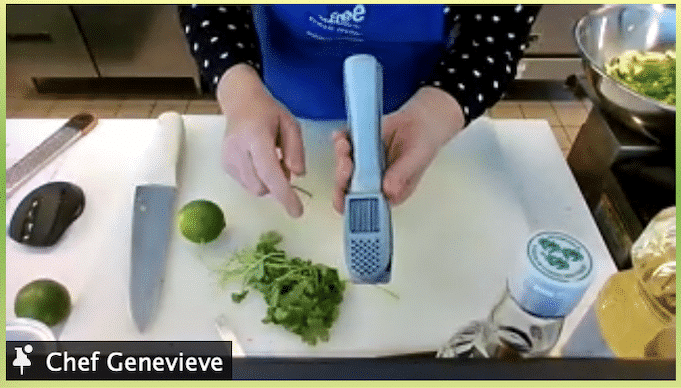
While Chef Genevieve makes the recipe
about half the students follow along and the rest watch. Questions about vocabulary and technique are asked and answered. Some of the words that need additional clarification are expertly entered simultaneously into the chat by Sally, who has a background in home economics education and an interest in literacy.
Fragrant, Mince, Uniform, Emulsify, Mushy, Pluck.
Chef Genevieve Cooks
Some students follow along with the chef while others just watch. Questions about vocabulary and technique are asked and answered. Some of the words that need additional clarification are expertly entered simultaneously into the chat by Sally, who has a background in home economics education and an interest in literacy.
Fragrant, Mince, Uniform, Emulsify, Mushy, Pluck…
FRENCH LENTIL SALAD
Edible Alphabet Lesson
In my first Edible Alphabet class, I watched as Chef Genevieve Guastella demonstrated. Genevieve is in her third year with Edible Alphabet in the library, combining her two greatest loves– libraries and cooking. She holds a BA in English Literature and Art History. After graduating, she decided to hone her baking skills and earned her Associates degree in Pastry Arts from The Restaurant School at Walnut Hill College in 2015. Chef Genevieve now bakes professionally in Philadelphia.
VIETNAMESE SPRING ROLLS
Edible Alphabet Lesson
In my second Edible Alphabet class, I prepared the Spring Rolls and Cucumber Salad with the class. Cooking together virtually was a thoroughly enjoyable experience, and everything was timed for a successful outcome. English language concepts were introduced organically as we watched, chopped, peeled, and cooked. The difference between “great” and “grate” was explained as we grated carrots and ginger. The proper usage of the word “fragrance” versus odor was “clarified” as we “sauteéd” onions, and roasted peanuts.
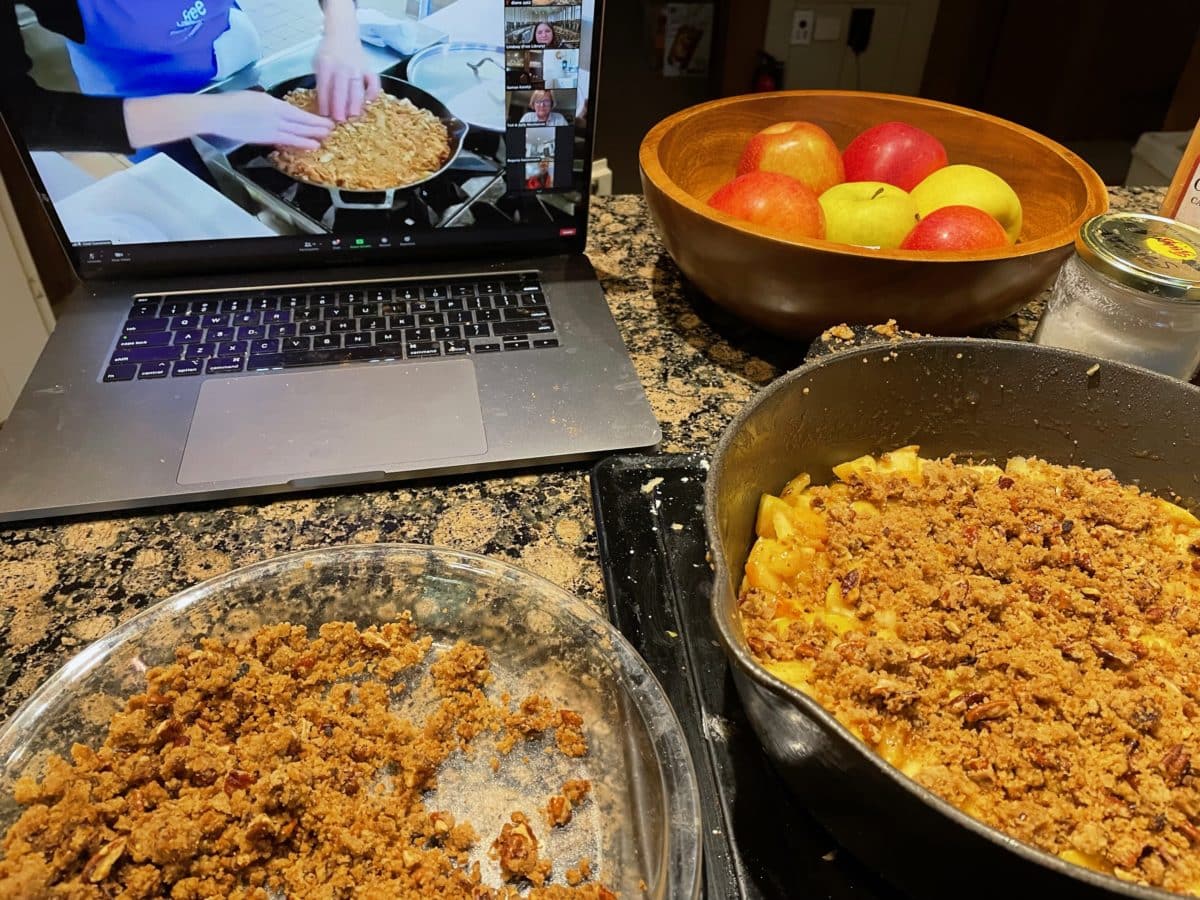
Introductions
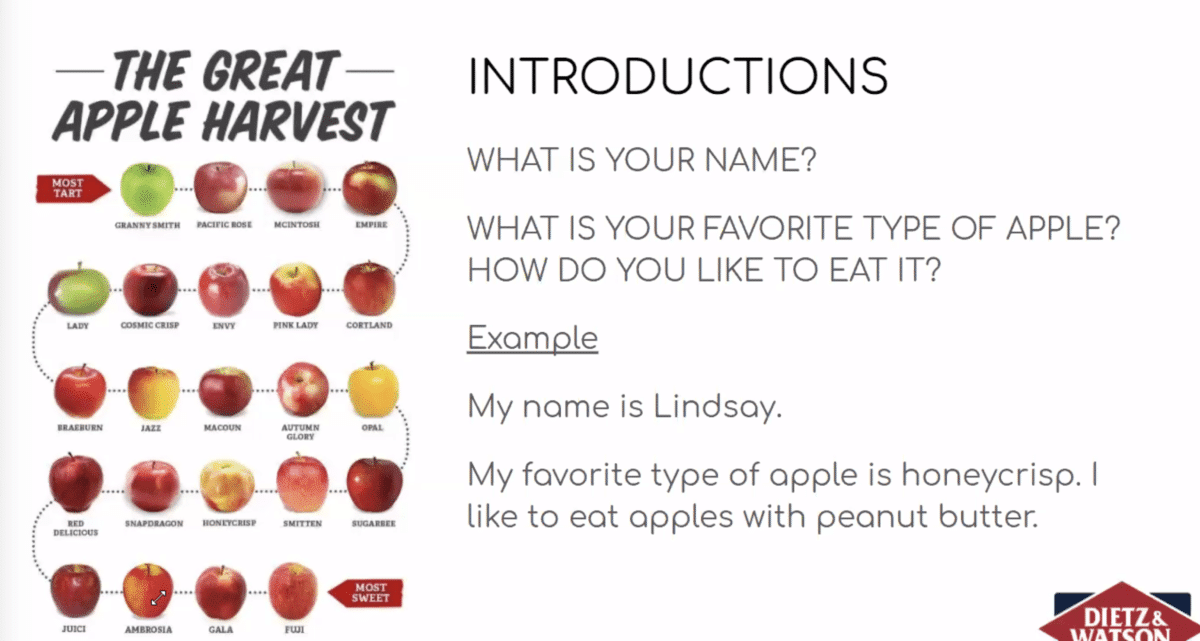
SKILLET APPLE CRISP ‘Easy as Pie’
This was a terrific class in which to participate. Native and non-native speakers alike learned about apple varieties in the introduction. Moreover, the quick and easy Apple Crisp recipe was delicious. And the topic lent itself to a discussion of food-related idioms such as “Apple of My Eye,” and of course, “As American as Apple Pie.”
Introductions

The Complete Edible Alphabet Fall 2021 Series
8/18 Spinach and Feta Orzo
8/25 Gado Gado Salad
9/1 Hummus and Flatbread
9/8 Macaroni and Cheese
9/15 Tortilla Soup
9/22 Bunny Chow
9/29 French Lentil Salad
10/6 Vietnamese Cucumber Salad and Spring Rolls
10/13 Apple Crisp
10/20 Shiro Wat*
10/27 Chirashizushi**
11/3 Arepas
Sharing Culinary Vocabulary
Everyone learns more than just English vocabulary in this class. Consequently, words from all cultures are explored while exploring global cuisine.
*Shiro Wat is an East African stew, most commonly associated with the countries Ethiopia and Eritrea. It is traditionally served on top of injera (fermented spongy flatbread).
**Chirashizushi is a Japanese term that translates to scattered sushi. This recipe combines sushi rice with vegetables and eggs for a tasty meal.
Not unsurprisingly, French words often appear in the recipes.
Sautéing or sauteing is a method of cooking that uses a relatively small amount of oil or fat in a shallow pan over relatively high heat.
Miirepoix is a flavor base made from diced vegetables cooked—usually with butter, oil, or other fat—for a long time on low heat without coloring or browning, as further cooking, often with the addition of tomato purée.
Related Story: Edible French, From Blog to Friendship to Book![]()
9/29 French Lentil Salad
10/6 Vietnamese Cucumber Salad and Spring Rolls
10/13 Apple Crisp
10/20 Shiro Wat*
10/27 Chirashizushi**
11/3 Arepas
“I love this program. I have seen first-hand how important this weekly connection has been to the participants. They grow in their knowledge of the English language, work to fit in in their new community, and form lasting friendships with their new friends who come from the four corners of the world. I have witnessed them master the language so that they can find jobs. Their stories, struggles and accomplishments keep me coming back.” – Sally, Member of the Culinary Literacy Center Advisory Council
